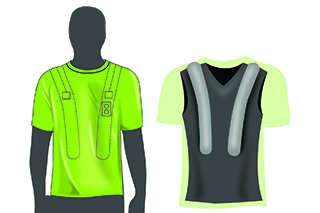College of Engineering News Room
Floating with Gas to Save Lives
By Brad Stager
About 10 lives are lost each day to unintentional drowning in the United States, but a newly-patented technology developed in a Chemical and Biomedical Engineering senior capstone class may lead to personal flotation products that can enhance safety in the water.

“The father wanted him to be safe when competing,” said Sunol. “So we made it a capstone design project for the course I teach.”Unlike commonly used bulky, foam-filled life vests, the flotation device designed by Professor Aydin Sunol’s Product and Process Design class is intended to be unobtrusive, inflating automatically only when needed, such as if a swimmer loses consciousness due to injury or illness. According to Sunol, that scenario was presented to him as a real-life problem needing a solution by the father of a chemical engineering undergraduate student who competed in triathlons, but had developed a propensity for seizures and was at a greater risk for drowning during the long-distance swim portions of the sport.
The class, under the direction of Sunol and Professor Chris Passaglia, began the task of creating a life-saving personal flotation device that is light enough not to impede performance and would provide buoyancy only when required. Inflation needed to occur automatically when the person wearing the vest is incapacitated, which added complexity to the problem.
“There were a lot of brainstorming sessions and we spent quite a few hours working on it,” said Sunol.
The shortcomings of what already exists in the marketplace showed the students that a different approach was needed.
Adaptive flotation devices supporting a variety of physical abilities offer greater safety to at-risk swimmers, such as people who have epilepsy or may not have complete use of their limbs. As with many of the common flotation devices, they are typically bulky, always buoyant and can further limit the range of movements a swimmer can perform.
There are also less restrictive inflatable life vests that require manual intervention to create buoyancy, such as by releasing carbon dioxide from small cartridges into the flotation device. However, being able to activate inflation may not be possible for a swimmer in distress.
The design that the class created uses body sensors to communicate with a programmed controller that can detect, through electromyography, muscular anomalies indicating a medical event such as a seizure. The controller then activates the mixing of small amounts of stored water and calcium hydride to generate hydrogen gas, filling integrated chambers within the swimming garment, which can be fashioned as a t-shirt or vest.
According to Sunol, one of the challenges was ensuring the gas flowed to where it would do the most good, without causing harm.
“Hydrogen in uncontrolled places is dangerous,” he said. We don’t want them flipped or subject to any other problems.” Another challenge required ensuring a proper mixture of the two substances to avoid generating heat that could cause burns.
By the end of the class, the students designed a personal flotation device that could benefit potentially millions of people who want to enjoy water activities more safely, including Alwyn Poole’s son Michael, a professional triathlete from New Zealand whose seizures made the swimming portion of the sport, which also includes running and cycling, especially dangerous. It was his personal competitive situation that showed the need for a new kind of personal flotation device.
Alwyn Poole, who is also a triathlete, says the unobtrusive, automatically inflatable features of the flotation device designed by the class makes it useful in a variety of settings ranging from backyard pools to a triathlon’s water course where there can be a lot of physical contact that poses a risk of injury to any swimming competitor.
“There’s arms, hands, legs everywhere, and you can get concussions going around the buoys.” Poole also said that many recreational swimmers have chronic or hidden medical conditions that could suddenly create a life-threatening situation for them in the water, and an automatically inflating life vest might be the difference between life and death.
“If I had a piece of technology like that, I would wear it,” Poole added.
Since graduating from USF with his bachelor of science in chemical engineering in 2016, Michael Poole has focused on running marathons and his professional career, which finds him working at Regeneron Pharmaceuticals in Albany, New York.
According to the Centers for Disease Control and Prevention, an average of 3,868 fatal drownings occur in the United States each year. The high number of deaths as well as serious injuries that result from drowning suggest there is room for the kind of innovation in personal water safety equipment that the students developed. The novel solution and its ability to meet a real need made the project a good candidate for a patent, according to Sunol.
“We were very happy with what we came up with and that’s when we started looking at the patent process,” he said.
The project, which utilized computer, mechanical, and chemical engineering principles to complete, also illustrates the College of Engineering’s transdisciplinary approach to educating students. Distinguished University Professor Robert Frisina, who is also chair of the Medical Engineering Department and director of biomedical engineering at USF, cited the project and resulting patent as exemplifying what is possible to accomplish in the classroom.
“It was very fulfilling for me, personally and professionally, to work with a team of very capable chemical and biomedical engineering students who came together to help a fellow student on a life-saving project,” he wrote in an email. “I learned a lot from Professors Sunol and Passaglia about how to turn an engineering idea into a patentable reality, at the intersection of two exciting engineering fields.”
The patent on the gas inflatable flotation device was awarded in September and is held by the University of South Florida. People interested in licensing the technology should contact the university’s Technology Transfer Office of USF Research and Innovation.
